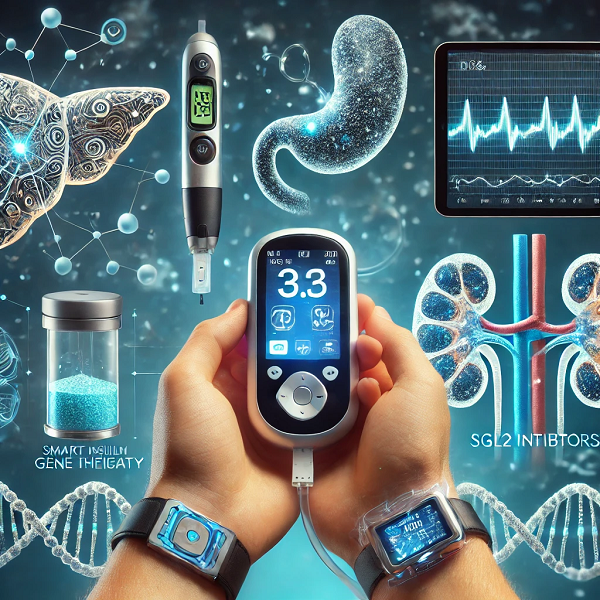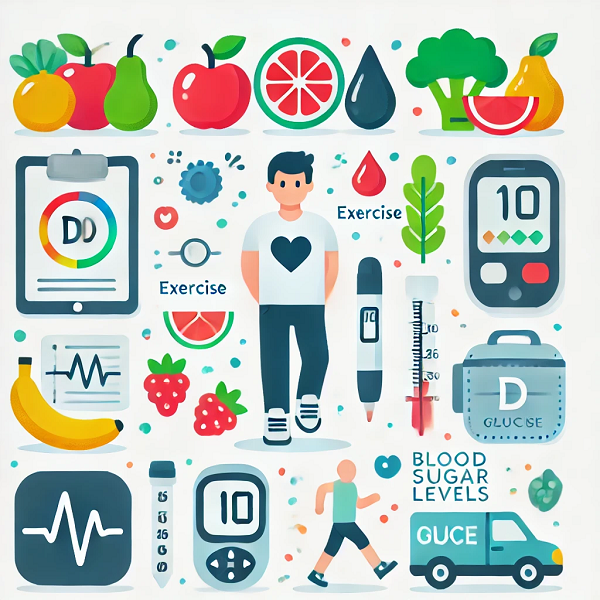Diabetes, a chronic condition affecting millions worldwide, requires ongoing management to maintain optimal health. Traditional treatments like insulin injections and oral medications have been the mainstay for decades. However, recent advancements in medical research have introduced innovative treatments that offer new hope for disease management. In this article, we will explore these cutting-edge treatments, their mechanisms, and their potential impact on the lives of those with diabetes.
1. Continuous Glucose Monitoring (CGM)
Continuous Glucose Monitoring (CGM) systems have revolutionized diabetes management by providing real-time glucose readings. Unlike traditional finger-stick tests that give a snapshot of blood glucose levels, CGMs continuously monitor glucose levels throughout the day and night. These devices consist of a small sensor inserted under the skin, a transmitter, and a receiver or smartphone app.
Benefits:
- Real-time data: Provides constant glucose level readings, allowing for better glucose management.
- Trends and patterns: Helps identify patterns and trends in blood sugar levels, aiding in more informed decision-making.
- Alerts: Warns users of high or low blood sugar levels, preventing severe episodes.
Studies have shown that CGMs can significantly reduce HbA1c levels and the risk of hypoglycemia.
2. Artificial Pancreas Systems
An artificial pancreas system combines a CGM with an insulin pump to automate insulin delivery. These systems use advanced algorithms to predict blood sugar levels and adjust insulin delivery accordingly. The goal is to mimic the glucose-regulating function of a healthy pancreas.
Types of Artificial Pancreas Systems:
- Hybrid Closed-Loop Systems: These systems require users to input mealtime carbohydrate counts, and they adjust basal insulin delivery automatically.
- Fully Automated Systems: Currently under development, these systems aim to manage blood sugar levels without user intervention.
Benefits:
- Improved glucose control: Provides more precise insulin delivery, leading to better glucose control.
- Reduced burden: Lessens the daily burden of diabetes management.
Research indicates that artificial pancreas systems can significantly improve glycemic control and quality of life for people with type 1 diabetes (JDRF).
3. SGLT2 Inhibitors
Sodium-glucose co-transporter 2 (SGLT2) inhibitors are a class of medications that help lower blood sugar levels by preventing glucose reabsorption in the kidneys. This results in excess glucose being excreted in the urine.
Examples of SGLT2 Inhibitors:
- Canagliflozin (Invokana)
- Dapagliflozin (Farxiga)
- Empagliflozin (Jardiance)
Benefits:
- Weight loss: Can promote weight loss, which is beneficial for many people with type 2 diabetes.
- Cardiovascular benefits: Studies have shown that SGLT2 inhibitors can reduce the risk of cardiovascular events (NEJM).
- Kidney protection: May offer protective benefits for kidney health (The Lancet).
4. GLP-1 Receptor Agonists
Glucagon-like peptide-1 (GLP-1) receptor agonists are injectable medications that mimic the action of the natural hormone GLP-1. They stimulate insulin secretion, inhibit glucagon release, and slow gastric emptying, which helps control blood sugar levels.
Examples of GLP-1 Receptor Agonists:
- Exenatide (Byetta)
- Liraglutide (Victoza)
- Semaglutide (Ozempic)
Benefits:
- Weight loss: Often lead to significant weight loss.
- Reduced appetite: Help reduce appetite, aiding in weight management.
- Cardiovascular benefits: Have been shown to reduce the risk of major cardiovascular events in people with type 2 diabetes (Circulation).
5. Closed-Loop Insulin Delivery Systems
Closed-loop insulin delivery systems, also known as “artificial pancreas” systems, represent a major breakthrough in diabetes care. These systems integrate CGM and insulin pump technologies with sophisticated algorithms to automatically adjust insulin delivery based on glucose levels.
How It Works:
- CGM Sensor: Continuously monitors glucose levels.
- Algorithm: Analyzes data and predicts glucose trends.
- Insulin Pump: Automatically adjusts insulin delivery in response to predicted glucose levels.
Benefits:
- Tighter glucose control: Maintains blood glucose levels within target range more effectively.
- Reduced risk of hypoglycemia: Decreases the risk of low blood sugar episodes.
- Improved quality of life: Lessens the burden of constant monitoring and manual insulin adjustments.
6. Islet Cell Transplantation
Islet cell transplantation involves transplanting insulin-producing beta cells from a donor pancreas into a person with type 1 diabetes. This innovative approach aims to restore the body’s ability to produce insulin naturally.
Procedure:
- Islet Isolation: Beta cells are isolated from a donor pancreas.
- Transplantation: The isolated cells are infused into the recipient’s liver.
- Engraftment: The transplanted cells begin to produce insulin.
Benefits:
- Insulin independence: Some recipients may achieve insulin independence or significantly reduce their insulin requirements.
- Improved glucose control: Can lead to better blood sugar management and reduced risk of complications.
While still in experimental stages, islet cell transplantation shows promise for people with severe type 1 diabetes who do not respond well to conventional therapies (Nature Medicine).
7. Gene Therapy
Gene therapy is an emerging field that holds potential for curing diabetes at the genetic level. Researchers are exploring various gene-editing techniques to modify or repair genes responsible for diabetes.
Approaches:
- Beta cell regeneration: Stimulating the regeneration of insulin-producing beta cells.
- Insulin gene therapy: Introducing genes that can produce insulin directly into the body.
Benefits:
- Long-term solution: Offers the potential for a long-term or permanent cure for diabetes.
- Reduced dependency on insulin: Could eliminate the need for daily insulin injections.
While still in the experimental phase, gene therapy represents a promising avenue for future diabetes treatment (Science).
8. Smart Insulin
Smart insulin, also known as glucose-responsive insulin, is designed to release insulin in response to rising blood sugar levels. This innovation aims to mimic the natural function of the pancreas more closely.
How It Works:
- Sensing: Smart insulin molecules sense glucose levels.
- Release: Insulin is released when blood sugar levels rise.
- Shut-off: Insulin release stops when blood sugar levels normalize.
Benefits:
- Improved glucose control: Provides more precise insulin delivery.
- Reduced risk of hypoglycemia: Lowers the risk of insulin over-delivery and subsequent hypoglycemia.
Smart insulin is currently under development and testing, but it holds significant promise for simplifying management and improving outcomes (Journal of Clinical Investigation).
The landscape of diabetes treatment is rapidly evolving, with numerous innovative therapies offering new hope for better management and improved quality of life. From advanced monitoring systems like CGMs and artificial pancreas systems to groundbreaking approaches like gene therapy and smart insulin, these treatments have the potential to transform the lives of millions living with diabetes. As research continues and these technologies become more widely available, the future looks promising for those managing this chronic condition.
References
- Diabetes Care. (2022). Continuous Glucose Monitoring and Improved Glycemic Control. Retrieved from Diabetes Care
- American Diabetes Association. (2021). Benefits of Continuous Glucose Monitoring in Diabetes. Retrieved from Diabetes.org
- JDRF. (2023). Artificial Pancreas Systems for Type 1 Diabetes. Retrieved from JDRF
- New England Journal of Medicine. (2021). Cardiovascular Outcomes with SGLT2 Inhibitors. Retrieved from NEJM
- The Lancet. (2022). Renal Benefits of SGLT2 Inhibitors. Retrieved from The Lancet
- Circulation. (2021). Cardiovascular Effects of GLP-1 Receptor Agonists. Retrieved from Circulation
- Diabetes Therapy. (2022). Weight Loss and GLP-1 Receptor Agonists. Retrieved from Diabetes Therapy
- Diabetes Technology & Therapeutics. (2023). Advances in Closed-Loop Insulin Delivery Systems. Retrieved from DTT
- Diabetes Care. (2022). Closed-Loop Insulin Delivery and Glycemic Control. Retrieved from Diabetes Care
- Nature Medicine. (2022). Islet Cell Transplantation and Diabetes. Retrieved from Nature Medicine
- Science. (2021). Gene Therapy for Diabetes: Current Status and Future Prospects. Retrieved from Science
- Journal of Clinical Investigation. (2023). Smart Insulin: Progress and Challenges. Retrieved from JCI
#Diabetes #InnovativeTreatments #CGM #ArtificialPancreas #SGLT2Inhibitors #GLP1ReceptorAgonists #IsletCellTransplantation #GeneTherapy #SmartInsulin #DiabetesManagement







